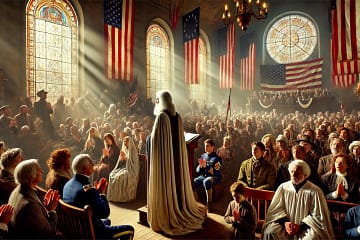“Young Goodman Brown” is a haunting short story by Nathaniel Hawthorne, set in the Puritan era of New England. It explores the fragile nature of faith, the complexities of good and evil, and the dark side of human nature. The story centers around Goodman Brown’s journey into the forest, both physically and metaphorically, as he confronts the duality of human existence and the struggle between sin and virtue.
Comprehensive Plot Summary
In the quiet Puritan village of Salem, a young man named Goodman Brown bids farewell to his beloved wife, Faith, one fateful evening. The pink ribbons of her cap flutter in the wind as she pleads with him to stay, for she is troubled by ominous dreams and thoughts. But Goodman Brown, filled with youthful resolve, assures her that he will return by sunrise and that no harm will come to her. With a heavy heart, Faith watches her husband disappear into the gathering dusk.
As Goodman Brown ventures into the forest, the shadows lengthen, and the trees seem to close in around him. He is filled with a sense of unease, aware that the lonely path may conceal unseen dangers. His mind wanders to tales of devilish Indians and imagines the devil himself lurking at his elbow. Suddenly, he is startled by the appearance of a man, decently attired and of grave demeanor, seated at the foot of an old tree. This stranger, who bears a striking resemblance to Goodman Brown himself, rises and joins him on his journey.
The traveller chides Goodman Brown for his lateness, revealing that he had expected to meet him sooner. As they walk, the young man expresses his scruples about the errand, but his companion persuades him to continue, promising to turn back if Goodman Brown remains unconvinced. The elder’s staff, carved in the likeness of a black snake, writhes as if alive, adding to the air of mystery surrounding him.
Goodman Brown’s thoughts turn to his pious ancestors, who had never embarked on such an errand. He questions his companion’s acquaintance with his family, including their involvement in acts of religious persecution and violence against the Quakers and Native Americans. The traveller boasts of his influence among the Puritans, claiming the friendship of deacons and governors. Disturbed, Goodman Brown resolves to part ways, but his companion quickly assuages his fears, offering him a maple branch to use as a walking stick.
As Goodman Brown strips the branch of its twigs, they wither and dry instantly, as if cursed. He and his companion continue their journey, their footsteps carrying them deeper into the forest’s gloom. Suddenly, Goodman Brown hears the sound of horses and recognizes the voices of the minister and Deacon Gookin. He hides, fearing discovery, as the riders pass by, their conversation revealing their unexpected destination in the wilderness.
Goodman Brown is filled with dismay and horror as he realizes that even the most revered members of his community are engaged in dark deeds. He cries out in anguish, his voice mingling with the laughter of the wind. In his despair, he declares that if Faith and heaven have abandoned him, he will embrace evil. With frenzied determination, he presses on, his staff now a symbol of his defiance against all that is holy.
The forest echoes with the sounds of his mad laughter and the howls of wild beasts. Suddenly, he finds himself in a clearing, where four blazing pines illuminate a rock that resembles an altar or pulpit. Gathered before it is a congregation of figures, their faces flickering in and out of the firelight. Among them, Goodman Brown recognizes pious matrons, respected elders, and even the minister and Deacon Gookin. He also sees Goody Cloyse and Martha Carrier, a notorious woman accused of witchcraft.
A dark figure, resembling a grave divine, stands before the congregation. In a solemn tone, he welcomes them, revealing that they have discovered the true nature of their desires and the sin that lurks within their hearts. He offers them a deeper understanding of evil and the hidden impulses that drive mankind.
Goodman Brown, trembling, sees Faith among the congregation, her veil now a symbol of her hidden sins. The dark figure prepares to baptize them, marking them forever as participants in this unholy communion. But Goodman Brown cries out, refusing to accept this fate. In an instant, the scene vanishes, leaving him alone in the forest, shaken and uncertain.
Returning to the village, Goodman Brown encounters Faith, her pink ribbons a stark contrast to his troubled soul. He cannot meet her gaze, for he has seen the darkness within her and himself. The story concludes with Goodman Brown’s descent into a life of sternness and despair, his faith forever shattered by the revelations of that night in the forest
Main Characters
Goodman Brown: The protagonist of the story, Goodman Brown is a young Puritan man who embarks on a journey that challenges his faith and moral convictions. He is initially confident in his righteousness but is confronted with the darkness within himself and others.
Faith: Goodman Brown’s wife, whose name symbolizes the innocence and purity he associates with her. She tries to dissuade him from his journey, expressing her own fears and intuitions.
The Traveller: A mysterious older man with a serpent-shaped staff, he accompanies Goodman Brown on his journey and serves as a guide or tempter figure. He represents the allure of sin and the devilish side of human nature.
Goody Cloyse: An elderly woman who had taught Goodman Brown his catechism. Her presence at the gathering in the forest disturbs Goodman Brown, as he associates her with piety and virtue.
Martha Carrier: A woman known for her wickedness and suspected of witchcraft. Her inclusion in the congregation of sinners reinforces the idea that even the most seemingly virtuous individuals have hidden darkness.
The Dark Figure: A sinister presence at the heart of the forest gathering, this figure represents the embodiment of evil and the devil. He offers baptism to Goodman Brown, marking him as a participant in the congregation of sinners.
Themes and Motifs
Good vs. Evil: The central theme of the story revolves around the struggle between good and evil, both within individuals and in society as a whole. Goodman Brown’s journey symbolizes the internal conflict between sin and virtue, as he discovers that even the most pious individuals have hidden darkness.
Faith and Doubt: Faith, both as a character and a concept, is central to the story. Goodman Brown’s faith is tested as he confronts the ambiguity of morality and the presence of evil in unexpected places. His journey leads him to question his beliefs and the nature of humanity.
Duality of Human Nature: The story explores the dual nature of human beings, suggesting that everyone has the capacity for both good and evil. The congregation in the forest represents the hidden sins and desires that lurk within even the most respectable individuals.
Isolation and Community: Goodman Brown’s journey is a solitary one, and his isolation in the forest reflects his internal struggle. However, the story also highlights the importance of community, as Goodman Brown’s actions impact not only himself but also those around him.
Symbolism of the Forest: The forest serves as a symbolic setting, representing the unknown, the mysterious, and the realm of the subconscious. It is a place where Goodman Brown confronts his fears, doubts, and the darker aspects of human nature.
Writing Style and Tone
Hawthorne’s writing style in “Young Goodman Brown” is characterized by a blend of realism and symbolism. The story is filled with vivid descriptions of the forest, creating a sense of foreboding and mystery. The language is often poetic, with a heavy emphasis on religious imagery and Puritan beliefs.
The tone of the story is dark and ominous, reflecting the themes of sin, doubt, and the struggle between good and evil. Hawthorne masterfully builds suspense, using Goodman Brown’s journey as a metaphor for the exploration of the human condition and the complexities of morality.


